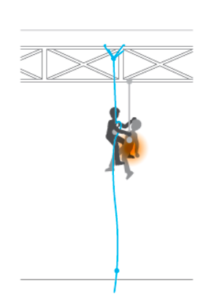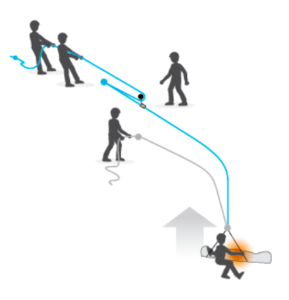Inspection and Maintenance with Rope Access
Introduction
Rope Access provides safe and rapid access to difficult-to-reach locations for testing, inspection and structural engineering functions without the use of cradles, scaffolding, or an aerial work platform. Progressing from techniques used in caving and rock climbing, the rope access industry has compiled an ideal safety record over the past thirty plus years while recording millions of man-hours.
Rope Access for Inspection
Rope access is known to be a safer alternative to conventional access methods, minimizing the amount of man power and the requirement for equipment on various projects without compromising on high degree of safety.

The method of rope access is commonly implemented to carry out the inspection of columns, piping, vessels, and other structures. Rope Access technicians commonly perform inspections using various nondestructive testing (NDT) methods. A team of rope access technicians has the capability to unite various crafts, enhancing the ability of the work being performed. This could be as easy as executing insulation work adding to an ultrasonic thickness inspection. In such a scenario, the team of rope access technicians can cut inspection windows, perform the inspection required, and close the inspection windows all at the same time. This type of proficiency could allow for a unit inspector to handle one team member who finishes the required work instead of coordinating with a scaffolding member, inspection member, and insulation member; allowing time for other responsibilities.
Rope access enables performing a greater degree of inspection. Inspections are no longer restricted to accessible areas near ladders and platforms, nor are they limited by the costs associated with erecting a scaffold, thanks to the additional accessibility rope access provides. Any part of the piping system or vessel is now accessible for inspection.
Moreover, while rope access team is working at height, areas that are not typically within view can be seen on the equipment, making it easy to work. Also, the team can spot irregularities that exist on other equipment in close proximity. Usually, these places are difficult to reach even during turnarounds and so they are typically not maintained.
Combined with Advanced NDE

When advanced NDT services are added, Inspection becomes even more powerful. Executing an AUT scan on the back side of a vessel or on remote piping can collect enormous amount of information. Technologies like Phased array UT on an elevated weld seam, eddy current scanning for surface cracking and tube inspections and guided wave UT to find welds and corrosion on long runs of pipe have been proven on their own merit, and rope access can make them more available and successful.
Rope Access for Maintenance
Rope access is not just limited to inspection. Tasks like welding, painting, insulation, electrical, mechanical work and cleaning can all be completed utilizing rope access. Using this technique, technicians have installed spring hangers, hung piping, insulated piping and vessels, and performed a lot of other tasks. Even if some say, scaffolding is cheaper, time saving is more valuable. Plants can take advantage of short time windows for completing projects, since work can be completed quickly.
In conjunction with conventional equipment and methods, rope access can also be used. Technicians tend to be good riggers; that certainly makes them more helpful on heavy lifts like flare tip changes with a crane. They can also make use of air tuggers. Very heavy equipment can be moved easily with the capability to set pulleys and re-direct quickly. Rope access technicians can also set staging for non-climbing workers.
Limitations
This technique has its own limitations as not every job is a best suited for rope access application. Rope access technicians are highly trained so their fees is typically higher than the comparable craft on the ground. Also, projects where a very large number of workers are needed, rope access is not be something that people prefer. Another limitation is around hot equipment. If the area is too hot, just like in case of heat exchanger fans, it might be at high-risk for rope access technicians to work.
Conclusion
Rope access is a valuable tool that enables operators to enhance the inspection and maintenance efforts. When used properly, rope access saves money and time, and makes facilities safer.
General Rope Access rescue principles
Inert suspension in a harness, even if its is for a little period of time, can cause serious physiological harm. It is important to intervene quickly with the suitable technique, in case of an accident.
Self-rescue
People must evacuate the building quickly on sites where the main access could be cut off by fire. With the evacuation kits available, you are provided with either a portable or a permanently installed solution on the structure. Use a hook-based system, in case there is no identified anchor possibility. But remember, in both cases, the teams must be regularly trained not to panic in case of a fire.
On-site rescue
Setting up a risk prevention plan by the company is important when a worksite is being set up.
1. It must safeguard the workforce from falls from height. The solutions whether it is collective or individual, should protect the personnels while working.
2. The company must be ready with rescue systems for accessing, releasing and evacuating the victim, in the case of an incident.
These solutions are established with:
- Rescue kits that are easy and ready-to-use and also adaptable to many situations
- Personal equipment for the technician at height (solution requiring well-trained and experienced teams)
The teams undergo regular training in both the cases, so they can respond quickly in case of an accident.
Technical rescue
The teams in technical rescue must be able to act speedily in any situation. They must choose the fastest and most effective way to approach and rescue the victim.
- It is suggested to easily transport the rescue equipment, in cases when access is simple or possible by motorized means
- While they may use rope access techniques, from above or below, in difficult access situations. They thus have lightweight, versatile equipment
- When victim access is complicated and/or remote, example in the mountains, the helicopter can be a means that can be used
Ski lift evacuation
Ski lift evacuation operations follow an evacuation plan. To meet the specific needs of each ski center, rescue kits are put together.

Image Source: Petzl
1. Accessing the victim
This can be complicated at times. Rope access techniques are used in such a case. In situations when access is feasible from above, rope descent techniques are used by rescuers. Rescuers can ascend the rope with rope clamps if an access rope is in place. While the rescuers are obliged to use climbing techniques in other situations in order to reach the victim.
Here are a few example of access from above

Image Source: Petzl
Here are a few example of access from below

Image Source: Petzl

Image Source: Petzl
2. Releasing the victim
Raising
This requires using a mechanical advantage pulley system to raise the victim with ease. In cases where the rescuer is alone, he will create such a system for conserving energy. The drawback here is that a long rope is required. A lower mechanical advantage is used if there are enough rescuers so as to speed up the operation.
Counterbalance technique
The victim is on one side and the rescuer on the other. This is a counterweight system. The rescuer first unweights the rope on the victim's side by pulling on it. The rescuer descends and the victim ascends. The advantage of this system is that it is easy to do with little equipment. Engaging the counterweight demands the most energy. Post that, one needs to be careful to keep the system under control. When there is a big weight difference between the rescuer and the victim, you need to be very careful.
Example of raising

Image Source: Petzl

Image Source: Petzl
Example of counterbalance

Image Source: Petzl

Image Source: Petzl

Image Source: Petzl
3. Evacuating the victim
This is the easiest technique in which downward, the evacuation is carried out with a descender. In cases where downward evacuation is not possible, the victim is evacuated horizontally or upward. Upward, rescuers use either a hauling technique or counterweight. Horizontally, one or more ropes are tensioned. One rope is used for back-up belay, another for carriage and another is used to move the litter.
Downward

Image Source: Petzl
Upward

Image Source: Petzl
Horizontally

Image Source: Petzl
----------------
Information Source: Petzl

